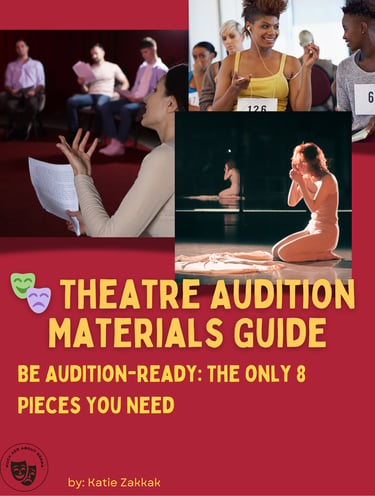Stanislavski Acting Method - Finding Motivation
Explore the Stanislavski acting method with this student-friendly guide to motivation in acting. Learn how objectives and high-stakes motivation create truthful, emotionally grounded performances—plus a free classroom-ready exercise.
THEATRE STUDENT RESOURCES
Katie Zakkak
9/29/20253 min read


Welcome!
This post is part of our Stanislavsky Acting Method series, focusing on one of the most essential elements for creating truthful performances: motivation.
🎭 Drama teachers: Feel free to share this post directly with your students as a ready-to-go mini lesson on motivation. You can also check out my Scene Partner Acting Unit and Monologue Unit for fully fleshed-out lessons.
A Quick Overview: What Is an Objective?
Before diving into motivation, it’s important to revisit a key foundation of Stanislavsky’s method: the objective.
👉 Your objective is what your character wants.
It can be a main goal that drives the entire play (the super-objective),
Or a smaller sub-objective that shows up in individual scenes.
A clear objective gives structure to your performance. But to bring it fully to life? You need to pair it with motivation.
What Is Motivation in Acting?
Motivation is your character’s why.
It’s the emotional engine behind your objective and answers the question:
“Why do I want what I want?”
While the objective tells you what to do, motivation tells you why you're doing it — and that “why” is what brings authenticity to your performance.
For example:
Two characters might want to win the same competition.
One is driven by a fear of failure.
The other is desperate for validation.
The stakes are completely different, and it changes everything about how those characters behave onstage.
Raising the Stakes: What Happens If They Fail?
One of the best ways to make your motivation stronger is to ask:
What does my character have to lose if they don’t achieve their objective?
Thinking in terms of loss rather than gain increases the emotional urgency.
A Real-Life Example:
Let’s say a student’s objective is to win a scholarship.
Basic motivation: “I want to win so I can afford college.”
High-stakes motivation: “If I don’t win, I won’t be able to attend at all — and I’ll miss my chance to help support my family and build a future.”
See how much more powerful that second one is? The character has something deeply personal and important to lose, and that creates tension, risk, and truth in the performance.
Motivation Example: Beauty and the Beast
Let’s take a look at Belle from Beauty and the Beast.
Her objective is clear: “I want adventure in the great wide somewhere.”
But her motivation gives the story emotional depth.
Why does she want that adventure so badly?
She’s isolated in her “poor provincial town.”
She’s mocked for reading and seen as strange.
Her father is the only person she truly connects with, and he’s aging.
If she stays in that town forever, she fears being alone, misunderstood, and never experiencing anything beyond books and dreams.
Suddenly, her desire for adventure isn’t just poetic. It’s desperation to escape a life of loneliness. And that’s the kind of motivation that leads to powerful performances.
Acting Exercise: Exploring Motivation in a Scene
This is a simple exercise you can use to bring more depth to any scene or monologue.
Motivation Practice Steps:
Choose a monologue or short scene (solo or with a partner).
Brainstorm three different motivations for your character.
Focus especially on what your character has to lose if they don’t succeed.
Don’t be afraid to imagine backstory or deepen what's suggested in the script.
Perform the piece three times, each time focusing on a different motivation.
Let the motivation guide your tone, movement, and emotional choices.
Don’t overthink it. Just observe what naturally changes.
Reflect:
Which version felt the most alive?
Which gave you the strongest emotional connection?
Which one raised the stakes and created more urgency?
This practice not only helps with character development. It trains you to make bold, specific choices in all your acting work.
Final Thoughts: Motivation Fuels Character
The key to believable acting isn’t just memorizing lines or “being emotional.” It’s understanding what drives your character at the deepest level.
When you uncover the why (the motivation), your performance becomes grounded, vulnerable, and true.
Want More?
🎁 For Student Actors:
Grab my FREE Audition Materials Guide — it includes the 8 essential pieces you need to be ready for any audition, plus tips on finding material that suits your strengths.
🎁 For Drama Teachers:
Download the FREE Drama Classroom Toolkit — includes character worksheets (like the one used for objective and motivation), lesson ideas, and student-friendly exercises. Signing up also adds you to my mailing list, where I share classroom strategies and new resources.
Happy acting — and break a leg!


